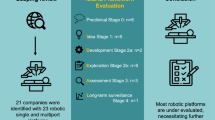Abstract
Comparative studies between robotic and laparoscopic cholecystectomy (LC) focus heavily on economic considerations under the assumption of comparable clinical outcomes. Advancement of the robotic technique and the further widespread use of this approach suggest a need for newer comparison studies. 676 ICG-aided robotic cholecystectomies (ICG-aided RC) performed at the University of Illinois at Chicago (UIC) Division of General, Minimally Invasive and Robotic Surgery were compiled retrospectively. Additionally, 289 LC were similarly obtained. Data were compared to the largest single institution LC data sets from within the US and abroad. Statistically significant variations were found between UIC-RC and UIC-LC in minor biliary injuries (p = 0.049), overall open conversion (p ≤ 0.001), open conversion in the acute setting (p = 0.002), and mean blood loss (p < 0.001). UIC-RC open conversions were also significantly lower than Greenville Health System LC (p ≤ 0.001). Additionally, UIC ICG-RC resulted in the lowest percentages of major biliary injuries (0 %) and highest percentage of biliary anomalies identified (2.07 %). ICG-aided cholangiography and the technical advantages associated with the robotic platform may significantly decrease the rate of open conversion in both the acute and non-acute setting. The sample size discrepancy and the non-randomized nature of our study do not allow for drawing definitive conclusions.

Similar content being viewed by others
References
Hussain A, Malik A, Halim MU, Ali AM (2014) The use of robotics in surgery: a review. Int J Clin Pract 68(11):1376–1382. doi:10.1111/ijcp.12492
Casella DP, Fox JA, Schneck FX, Cannon GM, Ost MC (2013) Cost analysis of pediatric robot-assisted and laparoscopic pyeloplasty. J Urol 189(3):1083–1086. doi:10.1016/j.juro.2012.08.259
Breitenstein S, Nocito A, Puhan M, Held U, Weber M, Clavien PA (2008) Robotic-assisted versus laparoscopic cholecystectomy: outcome and cost analyses of a case-matched control study. Ann Surg 247(6):987–993. doi:10.1097/SLA.0b013e318172501f
Villamere J, Gebhart A, Vu S, Nguyen NT (2015) Utilization and outcome of laparoscopic versus robotic general and bariatric surgical procedures at academic medical centers. Surg Endosc 29(7):1729–1736. doi:10.1007/s00464-014-3886-y
Altieri MS, Yang J, Telem DA, Zhu J, Halbert C, Talamini M et al (2015) Robotic approaches may offer benefit in colorectal procedures, more controversial in other areas: a review of 168,248 cases. Surg Endosc. doi:10.1007/s00464-015-4327-2
Daskalaki D, Fernandes E, Wang X, et al (2014) Indocyanine green (ICG) fluorescent cholangiography during robotic cholecystectomy: results of 184 consecutive cases in a single institution. Surg Innov 21(6):615–621. doi:10.1177/1553350614524839
Le VH, Smith DE, Johnson BL (2012) Conversion of laparoscopic to open cholecystectomy in the current era of laparoscopic surgery. Am Surg 78(12):1392–1395
Tantia O, Jain M, Khanna S, Sen B (2008) Iatrogenic biliary injury: 13,305 cholecystectomies experienced by a single surgical team over more than 13 years. Surg Endosc 22(4):1077–1086. doi:10.1007/s00464-007-9740-8
Ladocsi LT, Benitez LD, Filippone DR, Nance FC (1997) Intraoperative cholangiography in laparoscopic cholecystectomy: a review of 734 consecutive cases. Am Surg 63(2):150–156
McLean TR (2006) Risk management observations from litigation involving laparoscopic cholecystectomy. Arch Surg 141(7):643–648 (discussion 648)
Ford JA, Soop M, Du J, Loveday BP, Rodgers M (2012) Systematic review of intraoperative cholangiography in cholecystectomy. Br J Surg 99(2):160–167. doi:10.1002/bjs.7809
Pesce A, Portale TR, Minutolo V, Scilletta R, Li Destri G, Puleo S (2012) Bile duct injury during laparoscopic cholecystectomy without intraoperative cholangiography: a retrospective study on 1,100 selected patients. Dig Surg. 29(4):310–314. doi:10.1159/000341660
Buddingh KT, Morks AN, ten Cate Hoedemaker HO, Blaauw CB, van Dam GM, Ploeg RJ et al (2012) Documenting correct assessment of biliary anatomy during laparoscopic cholecystectomy. Surg Endosc 26(1):79–85. doi:10.1007/s00464-011-1831-x
Ishizawa T, Kaneko J, Inoue Y, Takemura N, Seyama Y, Aoki T et al (2011) Application of fluorescent cholangiography to single-incision laparoscopic cholecystectomy. Surg Endosc 25(8):2631–2636. doi:10.1007/s00464-011-1616-2
Kono Y, Ishizawa T, Tani K, Harada N, Kaneko J, Saiura A et al (2015) Techniques of fluorescence cholangiography during laparoscopic cholecystectomy for better delineation of the bile duct anatomy. Medicine 94(25):e1005. doi:10.1097/MD.0000000000001005
Ishizawa T, Bandai Y, Ijichi M, Kaneko J, Hasegawa K, Kokudo N (2010) Fluorescent cholangiography illuminating the biliary tree during laparoscopic cholecystectomy. Br J Surg 97(9):1369–1377. doi:10.1002/bjs.7125
Haresco JT. Novadaq Technologies Inc. Let there be light; initiating at market outperform. BioTuesdays Web site. http://biotuesdays.com/wp-content/uploads/2012/01/JMPJvs27814.pdf. Published December 20, 2011. Updated 2011. Accessed 28 Sep 2015
Jensen CC, Madoff RD (2016) Value of robotic colorectal surgery. Br J Surg 103(1):12–13. doi:10.1002/bjs.9935
Iavazzo C, Papadopoulou EK, Gkegkes ID (2014) Cost assessment of robotics in gynecologic surgery: a systematic review. J Obstet Gynaecol Res. 40(11):2125–2134. doi:10.1111/jog.12507
Author information
Authors and Affiliations
Corresponding author
Ethics declarations
Conflict of interest
Author Antonio Gangemi, Author Rick Danilkowicz, Author Fernando Enrique Elli, Author Francesco Maria Bianco, Author Mario Masrur and Author Pier Cristoforo Giulianotti declare that they have no conflict of interest pertinent to this study.
Research involving human participants and/or animals
All procedures followed were in accordance with the ethical standards of the responsible committee on human experimentation (institutional and national) and with the Helsinki Declaration of 1975, as revised in 2000 (5). Informed consent was obtained from all patients for being included in the study.
Informed consent
Informed consent was obtained from all individual participants included in the study.
Rights and permissions
About this article
Cite this article
Gangemi, A., Danilkowicz, R., Elli, F.E. et al. Could ICG-aided robotic cholecystectomy reduce the rate of open conversion reported with laparoscopic approach? A head to head comparison of the largest single institution studies. J Robotic Surg 11, 77–82 (2017). https://doi.org/10.1007/s11701-016-0624-6
Received:
Accepted:
Published:
Issue Date:
DOI: https://doi.org/10.1007/s11701-016-0624-6




